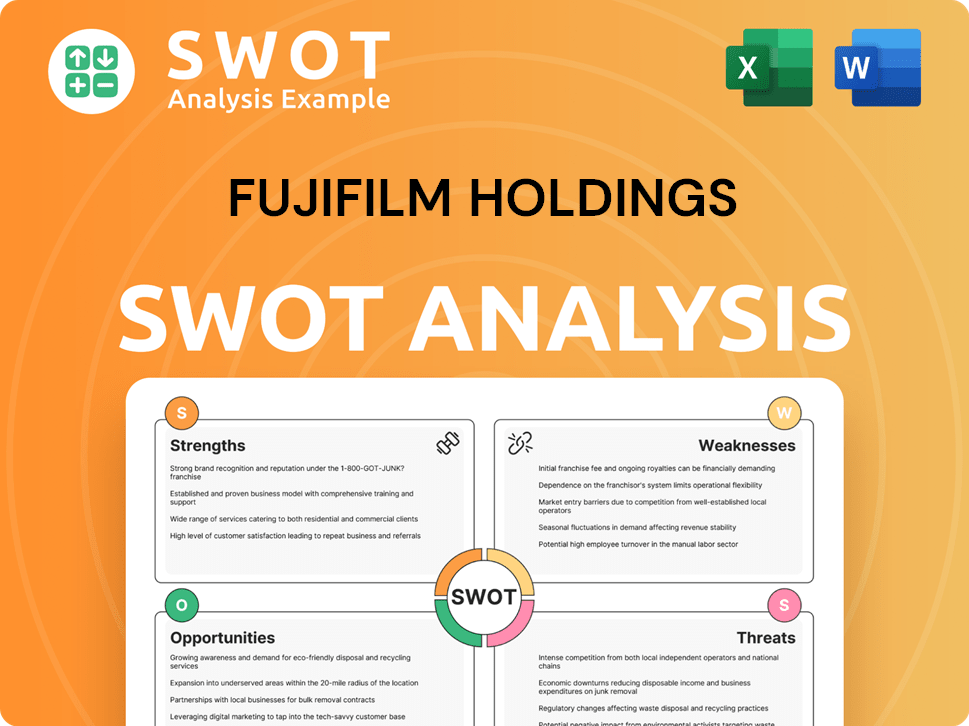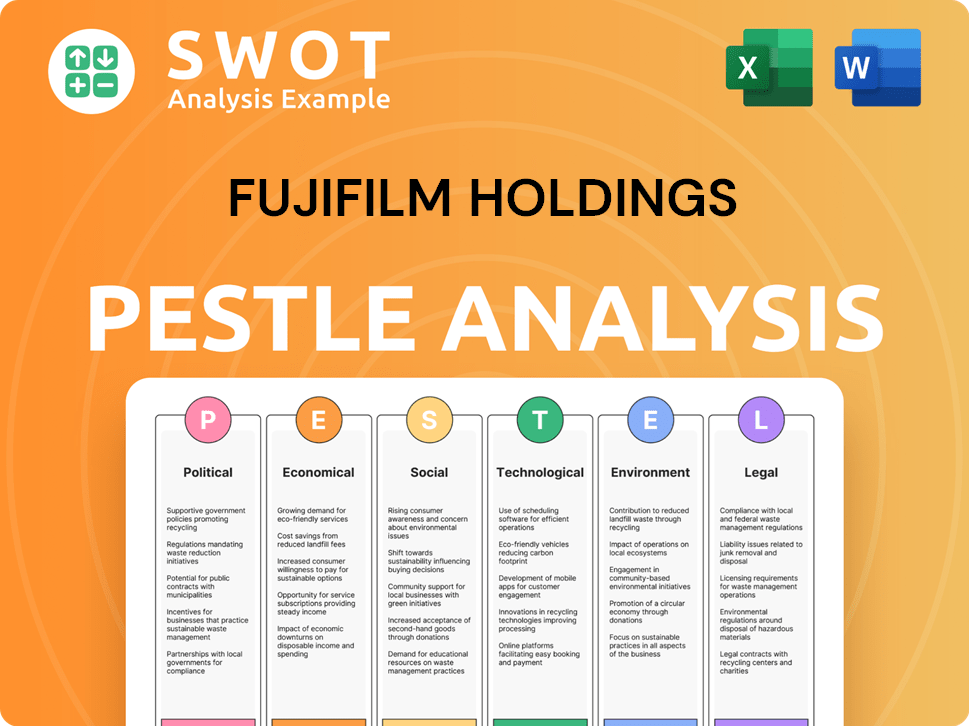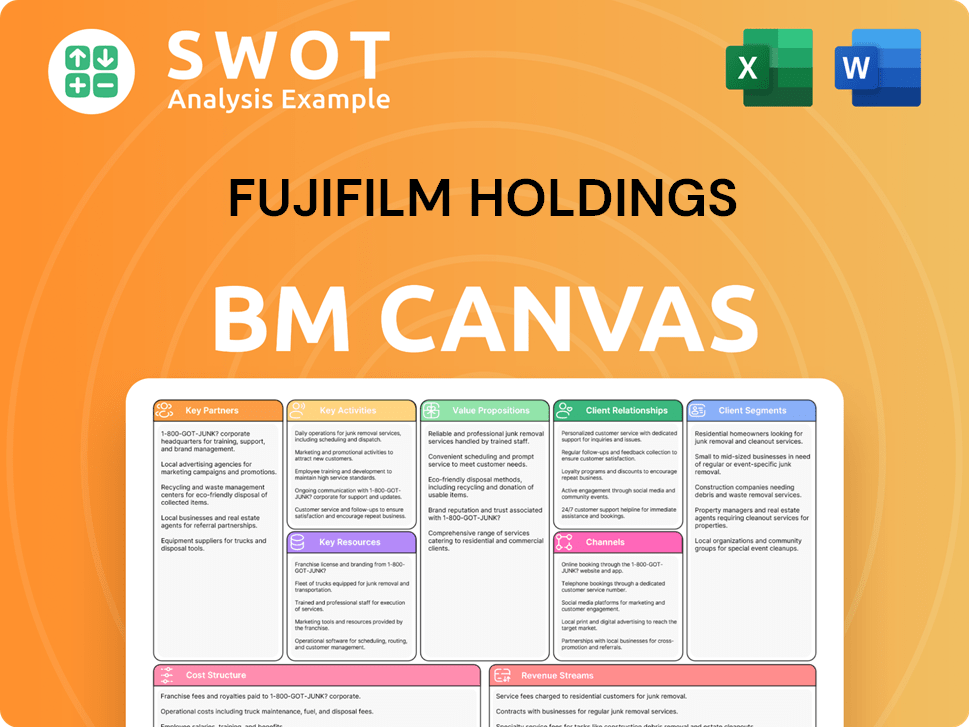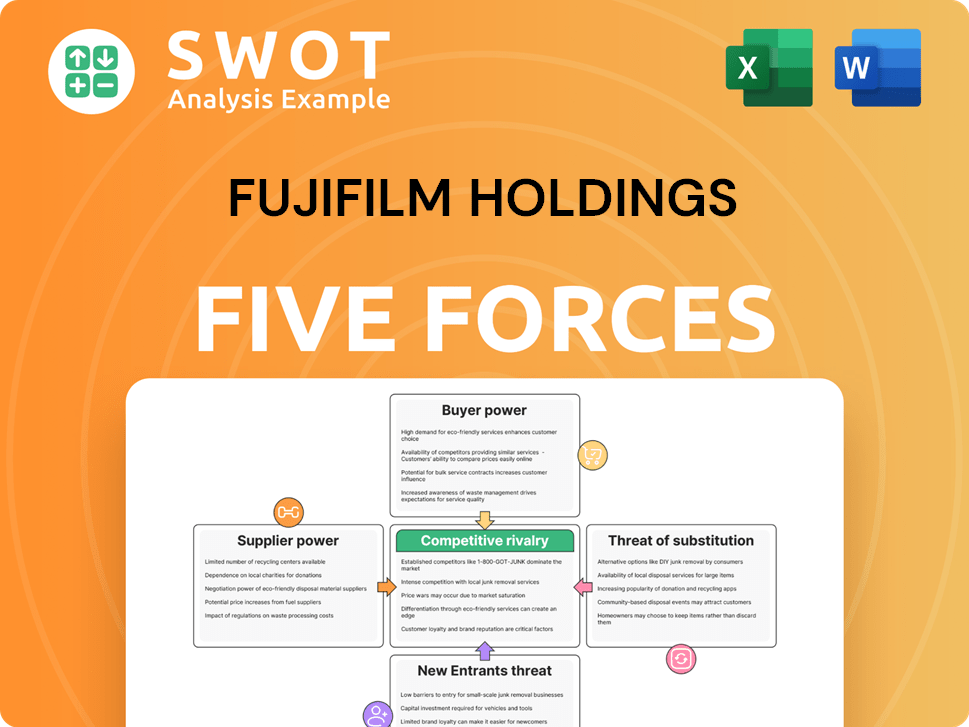Fujifilm Holdings Bundle
Can Fujifilm's Sales and Marketing Strategies Continue to Drive Growth?
From its origins in photographic film to its current status as a diversified technology leader, Fujifilm Holdings Company has masterfully navigated market shifts. Discover how this Japanese giant transformed its Fujifilm Holdings SWOT Analysis to adapt to changing consumer demands and technological advancements. Explore the innovative sales and marketing strategies that have propelled Fujifilm's success in competitive global markets.

This analysis delves into Fujifilm's multifaceted approach, examining its Fujifilm sales strategy and Fujifilm marketing strategy across diverse sectors like healthcare and advanced materials. We'll dissect Fujifilm's business model, conduct a thorough Fujifilm market analysis, and evaluate its Fujifilm competitive advantage. Uncover the secrets behind Fujifilm's impressive financial performance, including its recent revenue growth and strategic vision for the future, offering actionable insights for investors and business strategists alike.
How Does Fujifilm Holdings Reach Its Customers?
The sales channels of Fujifilm Holdings Company are diverse, reflecting its wide range of products and services. The company employs a multi-channel distribution strategy that includes direct sales, wholesale distributors, and retail partners. This approach is complemented by a growing emphasis on e-commerce platforms and the company's own website, adapting to changing market dynamics and consumer preferences.
Fujifilm's approach to sales and marketing is multifaceted, with strategies tailored to each business segment. For instance, the Business Innovation segment, which includes office solutions and graphic communications, has been expanding its sales efforts in the U.S. market since October 2024. This expansion leverages major local distributors for products like the 'Apeos' series and 'Revoria Press' series, following a broader international push since April 2021. This demonstrates Fujifilm's commitment to enhancing its market presence through strategic channel development.
In the healthcare segment, Fujifilm utilizes direct sales and partnerships with medical institutions. This includes integrating digital technologies, especially in medical imaging, to engage with various communities. Fujifilm's Bio CDMO business is also a key area of focus, with a sales target of 200 billion yen by FY2025. This will be supported by large-scale manufacturing facilities, such as the Denmark site, where the first phase of expansion was completed in November 2024. Fujifilm's strategic emphasis enhances its presence and strengthens its operational capabilities across various product lines.
Fujifilm's direct sales teams work alongside partnerships to reach customers. These partnerships are crucial in the healthcare segment, where they integrate cutting-edge digital technologies, especially in medical imaging. This strategy helps Fujifilm engage with various communities and expand its market reach.
Fujifilm utilizes wholesale distributors and retail partners to broaden its distribution network. The expansion in the U.S. market for the Business Innovation segment, leveraging major local distributors, exemplifies this approach. These channels are essential for reaching a wide customer base.
Fujifilm is increasing its focus on e-commerce platforms and its own website. This reflects the company's adaptation to changing consumer behavior and the growing importance of online sales channels. This strategy is vital for reaching a global audience.
Fujifilm's healthcare segment includes initiatives like health screening centers. The opening of a NURA health screening center in Hanoi, Vietnam, in July 2024, using Fujifilm's medical equipment and AI technology, is a prime example. This expansion builds on existing centers in India and Mongolia.
Fujifilm's sales strategy involves key partnerships and global expansion. The company's Bio CDMO business, with a 200 billion yen sales target by FY2025, is a significant area of growth. Strategic alliances, such as the 10-year manufacturing agreement with Regeneron Pharmaceuticals, Inc., valued at over US$3 billion, boost production.
- Fujifilm's global sales performance is enhanced through strategic channel development.
- The company's distribution channels for photographic film and other products are constantly evolving.
- Fujifilm's marketing strategies in Asia, particularly in healthcare, are expanding.
- The company's digital transformation in sales and marketing is ongoing.
Fujifilm Holdings SWOT Analysis
- Complete SWOT Breakdown
- Fully Customizable
- Editable in Excel & Word
- Professional Formatting
- Investor-Ready Format

What Marketing Tactics Does Fujifilm Holdings Use?
The marketing tactics employed by Fujifilm Holdings Company are multifaceted, blending digital and traditional strategies to boost brand awareness, generate leads, and drive sales. Their approach is data-driven, focusing on customer segmentation to tailor campaigns and product development to meet specific consumer preferences. The company’s Fujifilm marketing strategy incorporates the seven Ps of marketing: Price, Place, Promotion, Product, Physical Evidence, Process, and People.
Fujifilm's digital marketing efforts include content marketing, search engine optimization (SEO), paid advertising, email marketing, and influencer partnerships, alongside active engagement on social media platforms. Traditional media such as television, radio, and print advertising, along with trade shows and exhibitions, also play a vital role in their promotional activities. These diverse tactics support Fujifilm sales strategy by reaching a broad audience and reinforcing brand presence.
In 2024, Fujifilm's digital campaigns target millennials aged 15 to 45. For example, the Instax line appeals to Gen Z and millennials by leveraging nostalgia and trendy marketing approaches. This targeted approach helps Fujifilm Holdings Company to maintain and grow its market share. To understand the company's origins, read the Brief History of Fujifilm Holdings.
Fujifilm utilizes a comprehensive digital marketing strategy. This includes content marketing, SEO, paid advertising, email marketing, and influencer collaborations.
Traditional media like TV, radio, and print advertising are still used. Trade shows and exhibitions are also leveraged to showcase innovations and build relationships.
Fujifilm focuses on specific demographics with its marketing campaigns. The Instax line, for example, targets Gen Z and millennials.
Customer segmentation, particularly psychographic segmentation, is used to create targeted campaigns. This helps in developing products that meet unique customer needs.
Fujifilm localizes user interfaces and uses translation technology to improve customer experience across different demographics.
The company integrates the seven Ps of marketing: Price, Place, Promotion, Product, Physical Evidence, Process, and People, to adapt to market changes and consumer expectations.
Fujifilm’s marketing tactics are designed to build brand strength and enhance customer engagement. These tactics include digital marketing, traditional media, and data-driven approaches.
- Digital Marketing: Content marketing, SEO, paid advertising, email marketing, and influencer partnerships.
- Traditional Media: TV, radio, and print advertising, alongside trade shows and exhibitions.
- Targeted Campaigns: Focusing on specific demographics like millennials and Gen Z.
- Data-Driven Marketing: Customer segmentation, especially psychographic segmentation, to tailor campaigns and product development.
- Localization: Localizing user interfaces and using translation technology to enhance customer experience.
- Integrated Marketing Mix: Applying the seven Ps of marketing to adapt to market changes and consumer expectations.
Fujifilm Holdings PESTLE Analysis
- Covers All 6 PESTLE Categories
- No Research Needed – Save Hours of Work
- Built by Experts, Trusted by Consultants
- Instant Download, Ready to Use
- 100% Editable, Fully Customizable

How Is Fujifilm Holdings Positioned in the Market?
The brand positioning of Fujifilm is built on a foundation of innovation and quality, aiming to deliver exceptional value to its diverse customer base. This strategy is evident in its core message, 'Value from Innovation,' which drives its technological advancements and commitment to enhancing the quality of life. Fujifilm's approach extends beyond traditional photography, encompassing healthcare, highly-functional materials, and business solutions, showcasing its adaptability and forward-thinking approach.
Fujifilm maintains a consistent brand identity across all channels, from product design to communication strategies. This commitment to quality helps build and maintain customer loyalty. To stay competitive and meet changing consumer demands, Fujifilm proactively adjusts its strategies, such as reorganizing business segments to focus on healthcare and highly-functional materials, demonstrating its adaptive brand positioning. This focus helps to unify and simplify customer engagement globally.
Fujifilm's brand consistently communicates reliability, precision, and a forward-thinking approach, appealing to a broad range of customers who value innovation and affordability. This is crucial for maintaining its market position and driving future growth. The company's ability to adapt and innovate is key to its long-term success in a competitive market.
Fujifilm's sales strategy focuses on expanding its presence in high-growth sectors like healthcare and materials. The company leverages its technological expertise to offer innovative products and solutions. This approach is supported by strong partnerships and a global distribution network.
The Fujifilm marketing strategy emphasizes brand consistency and customer engagement across all touchpoints. Digital marketing, including social media, plays a crucial role in reaching target audiences. The company also invests in advertising campaigns that highlight product quality and innovation.
Fujifilm's business model is diversified, with a significant focus on healthcare, highly-functional materials, and imaging solutions. The company invests heavily in research and development to drive innovation. Strategic acquisitions and partnerships support its growth objectives.
Fujifilm's competitive advantage lies in its innovation, quality, and diversification across various sectors. Strong brand recognition and customer loyalty are key assets. The company's ability to adapt to market changes and technological advancements is also crucial.
Recent rebranding efforts, such as FUJIFILM Business Innovation Australia's transformation and the rebranding of its Life Sciences Group companies as FUJIFILM Biosciences and FUJIFILM Biotechnologies in June 2025, demonstrate Fujifilm's adaptive brand positioning. These moves aim to unify and simplify customer engagement globally.
- Fujifilm is strategically reorganizing its business segments to align with long-term growth goals, prioritizing healthcare and highly-functional materials.
- The company's commitment to product quality aligns with consumer expectations, ensuring ongoing loyalty.
- Fujifilm continues to invest in research and development to drive innovation and maintain its competitive edge.
- Growth Strategy of Fujifilm Holdings reveals further insights into the company's strategic direction.
Fujifilm Holdings Business Model Canvas
- Complete 9-Block Business Model Canvas
- Effortlessly Communicate Your Business Strategy
- Investor-Ready BMC Format
- 100% Editable and Customizable
- Clear and Structured Layout

What Are Fujifilm Holdings’s Most Notable Campaigns?
The Fujifilm sales strategy and marketing strategy incorporates various campaigns across its diverse business segments. These campaigns are designed to drive revenue growth and strengthen the company's market position. Fujifilm's approach includes strategic investments, innovative product launches, and targeted marketing efforts to reach specific customer segments.
Fujifilm Holdings Company focuses on initiatives that leverage its strengths in healthcare, imaging, and business solutions. The company's marketing strategy aims to build brand recognition and customer loyalty. Fujifilm's competitive advantage comes from its ability to adapt to market changes and capitalize on emerging opportunities.
A key focus is the Bio CDMO business, with a goal of achieving 200 billion yen in sales by FY2025. This segment's success is supported by major contracts and expanded production capacity.
Fujifilm's Bio CDMO business is a significant growth area. The company aims to become a 'Trusted Partner' in life sciences. This involves providing end-to-end services, from early drug development to commercial production.
The Healthcare segment benefits from increased capacity and strategic partnerships. The new large-scale facilities in Denmark, launched in November 2024, contribute to revenue growth. The company's focus is on expanding its capabilities in this sector.
The X100VI camera launch exemplifies Fujifilm's marketing strategy. Strategic value-based pricing supports the product's quality. The Instax instant photo systems have also been successful.
Instax sales boosted revenue in the Imaging segment by 24.2% year-over-year to JPY 105.2 billion in the first quarter of fiscal year 2024. Operating income increased by 38.9% year-over-year to JPY 32.5 billion. These campaigns target Gen Z and millennials.
In the business solutions sector, a new go-to-market campaign, 'Work Happily Ever After,' launched in March 2025 by FUJIFILM Business Innovation Australia, marked a strategic shift. This campaign highlights the company's expanded offerings, including consulting, managed IT services, and advanced communication solutions. The focus is on meeting client needs and integrating comprehensive business services.
Fujifilm's partnerships and collaborations are integral to its growth strategy. The 10-year manufacturing agreement with Regeneron Pharmaceuticals, Inc. for antibody drugs, valued at over US$3 billion, is a prime example.
Fujifilm is undergoing digital transformation in sales and marketing. This involves integrating new technologies and strategies to enhance customer engagement and streamline operations.
Fujifilm's marketing strategy includes targeted campaigns. The Instax campaign targets Gen Z and millennials. Fujifilm's marketing campaigns for X-series cameras also focus on specific demographics.
Fujifilm's global sales performance is driven by its diverse product portfolio. The company's marketing strategies in Asia are particularly important for its overall sales growth.
Fujifilm's pricing strategy is crucial for its success. Value-based pricing for products like the X100VI camera reflects their quality and innovation. The company's pricing strategy for healthcare products is also a key consideration.
Fujifilm's customer relationship management (CRM) approach is essential. The company's content marketing strategy examples help engage customers. The company's approach to customer engagement is a key element of its marketing efforts.
Fujifilm Holdings Porter's Five Forces Analysis
- Covers All 5 Competitive Forces in Detail
- Structured for Consultants, Students, and Founders
- 100% Editable in Microsoft Word & Excel
- Instant Digital Download – Use Immediately
- Compatible with Mac & PC – Fully Unlocked

Related Blogs
- What are Mission Vision & Core Values of Fujifilm Holdings Company?
- What is Competitive Landscape of Fujifilm Holdings Company?
- What is Growth Strategy and Future Prospects of Fujifilm Holdings Company?
- How Does Fujifilm Holdings Company Work?
- What is Brief History of Fujifilm Holdings Company?
- Who Owns Fujifilm Holdings Company?
- What is Customer Demographics and Target Market of Fujifilm Holdings Company?
Disclaimer
All information, articles, and product details provided on this website are for general informational and educational purposes only. We do not claim any ownership over, nor do we intend to infringe upon, any trademarks, copyrights, logos, brand names, or other intellectual property mentioned or depicted on this site. Such intellectual property remains the property of its respective owners, and any references here are made solely for identification or informational purposes, without implying any affiliation, endorsement, or partnership.
We make no representations or warranties, express or implied, regarding the accuracy, completeness, or suitability of any content or products presented. Nothing on this website should be construed as legal, tax, investment, financial, medical, or other professional advice. In addition, no part of this site—including articles or product references—constitutes a solicitation, recommendation, endorsement, advertisement, or offer to buy or sell any securities, franchises, or other financial instruments, particularly in jurisdictions where such activity would be unlawful.
All content is of a general nature and may not address the specific circumstances of any individual or entity. It is not a substitute for professional advice or services. Any actions you take based on the information provided here are strictly at your own risk. You accept full responsibility for any decisions or outcomes arising from your use of this website and agree to release us from any liability in connection with your use of, or reliance upon, the content or products found herein.